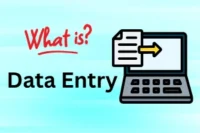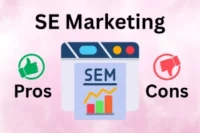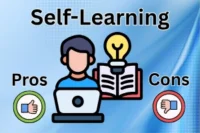Guide to Different Content Types: Find What Works!
Published: 12 Oct 2025
In today’s digital world, content is king. But with so many options available, it can be overwhelming to know where to start. This article will break down the different types of content you can create, helping you choose the right format to engage your audience and achieve your goals.
Let’s start with the content’s definition.
Types of Content
Here’s a comprehensive list of all the content types. Starting with the basic one type and then further diving into its parts.
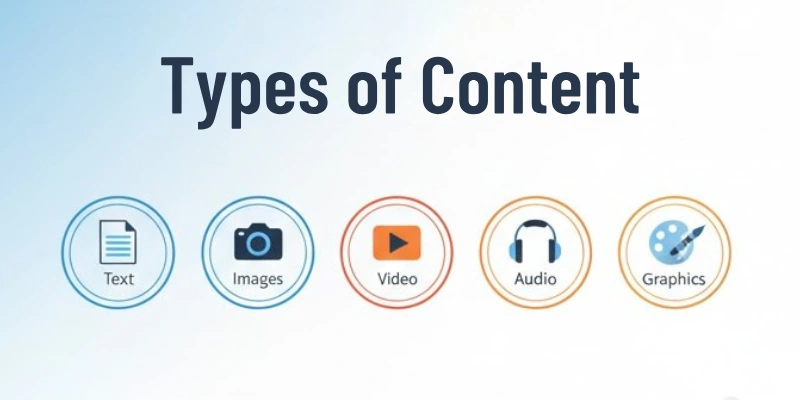
Written Content
Most internet communication begins with written content. It includes all knowledge explained through the written word and can take many creative forms. This section will go over numerous sorts of written content and discuss its purpose, benefits, and potential problems.
Blog Posts
Informative articles appearing on a website or blog, typically tackling current trends, industry news, or specific topics of interest to the audience.
- Example: A industry news blog might publish a post titled “Why your Website is Not Ranking – Explore Expert’s Thoughts”
- Pros: Builds brand awareness, establishes expertise, encourages audience interaction.
- Cons: Requires consistent content creation, may not generate immediate results.
Articles
In-depth pieces exploring a particular subject, often published on websites, news platforms, or magazines.
- Example: A scientific journal might publish an article on “The Latest Advancements in Cancer Research.”
- Pros: Provides valuable insights, builds credibility, and can attract backlinks for SEO.
- Cons: Can be time-consuming to research and write, may have a limited audience depending on the topic.
Ebooks
Electronic books offering extended information on a specific subject. They can be free or paid downloads.
- Example: An entrepreneur might offer a free ebook titled “The Ultimate Guide to Starting Your Business.”
- Pros: Provides comprehensive knowledge, establishes authority, can be used as a lead magnet.
- Cons: Requires significant writing effort, may face competition from existing content.
White Papers
Persuasive reports aimed at a technical audience, typically used for B2B marketing.
- Example: A software company might publish a white paper on “The Benefits of Cloud-Based Security Solutions.”
- Pros: Positions brand as a thought leader, educates potential customers, promotes specific products or services.
- Cons: Content needs to be highly informative and credible, may not be suitable for a general audience.
Case Studies
Real-world examples showcasing how a company or product helped a client achieve success.
- Example: A marketing agency might publish a case study on “How We Increased Website Traffic by 200% for Client X.”
- Pros: Builds trust and social proof, demonstrates expertise, showcases effectiveness.
- Cons: Requires client approval and success stories, may not be universally applicable.
Press Releases
Official announcements issued to the media to share newsworthy information about a company or organization.
- Example: A tech startup might issue a press release announcing the launch of their innovative new product.
- Pros: Generates media coverage, builds brand awareness, increases public visibility.
- Cons: Effectiveness relies on newsworthiness of content, requires crafting a compelling message.
Email Newsletters
Regular electronic publications delivered directly to subscribers’ inboxes, containing updates, promotions, and valuable content.
- Example: A clothing store might send a monthly newsletter featuring new arrivals, fashion tips, and exclusive discounts.
- Pros: Direct communication, promotes engagement, drives sales.
- Cons: Build an email list, keep subscribers interested, and follow anti-spam standards.
Guides
Comprehensive instructions or explanations on a specific topic, aiming to educate and encourage readers.
- Example: A website might offer a guide titled “The Beginner’s Guide to SEO”
- Pros: Provides valuable resources, improves user experience, establishes expertise.
- Cons: Requires in-depth knowledge of the subject, maintaining content accuracy and updates.
How-To Lists
Step-by-step instructions that guide readers through a specific process in a clear and concise manner.
- Example: A cooking blog might publish a how-to list on “How to Make the Perfect Chocolate Chip Cookies.”
- Pros: Easy to understand and follow, promotes user engagement, increases website traffic.
- Cons: Content saturation may occur for common topics, requires clear and concise writing.
Checklists
Simple lists of tasks or items that need to be completed, designed to enhance organization and efficiency.
- Example: A digital marketing website might offer a checklist for “SEO Check-List This Year”
- Pros: Improves user experience, promotes efficient task completion, easily shareable.
- Cons: May seem basic for complex topics, requires concise and actionable items.
Reports
Formal documents presenting information or findings from research, analysis, or data collection.
- Example: A marketing team might create a report on “Social Media Marketing Campaign Performance”
- Pros: Provides data-driven insights, supports decision-making, encourages transparency.
- Cons: Can be dense and technical, requires clear presentation and visuals.
Scripts
Written blueprints for filmed productions, plays, or presentations, outlining dialogue, actions, and stage directions.
- Example: A screenwriter might pen a script for a new comedy film.
- Pros: Brings stories and ideas to life, provides a roadmap for production, allows for creative expression.
- Cons: Requires specific formatting and knowledge, competitive industry for script adoption.
Short Stories
Fictional narratives of a limited length, focusing on character development, plot, and theme.
- Example: A literary magazine might publish a short story about a futuristic adventure.
- Pros: Encourages creativity and emotional connection, showcases writing skills, can be published in various platforms.
- Cons: Requires strong storytelling ability, may not be suitable for all audiences.
Novels
Lengthy fictional narratives exploring complex characters, plots, and themes over multiple chapters.
- Example: A fantasy author might write a book about a young wizard who sets out to beat an evil magician.
- Pros: Goes into great detail about a made-up world, lets characters grow and change, and has the potential for a lot of fans and royalties.
- Cons: Demands significant time and dedication, requires in-depth plot planning and editing.
Poems
Verse compositions that use language for rhythm, imagery, and emotional expression.
- Example: A collection of poems might explore themes of love, loss, and nature.
- Pros: Encourages creative expression and exploration of language, can be emotionally resonant, suitable for online platforms and publications.
- Cons: May not appeal to all audiences, requires strong language skills and understanding of poetic form.
Song Lyrics
Words written to accompany music, expressing emotions, stories, and ideas through melody and verse.
- Example: A songwriter might create lyrics for a pop song about heartbreak.
- Pros: Powerful tool for emotional connection, allows collaboration with musicians, potential for commercial success.
- Cons: Requires understanding of musical structure and rhythm, competitive music industry.
Infographics
Informational graphics that combine text, data, and visuals to present complex information in a visually appealing way.
- Example: An infographic might showcase the “Top 10 Travel Destinations for 2024.”
- Pros: Enhances data comprehension, increases user engagement, easily shareable across platforms.
- Cons: Requires design skills and data visualization knowledge, ensuring accuracy of information is crucial.
Visual Content
Any kind of information that can be shown in pictures, drawings, or videos. It includes a wide range of creative forms that are used for different reasons and by different groups of people.
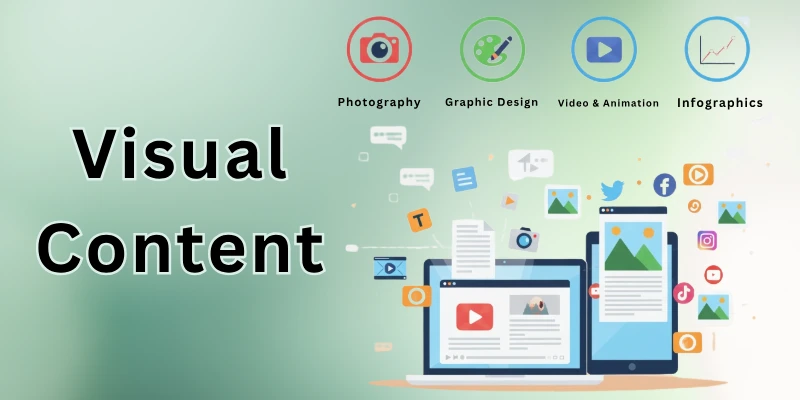
Images & Photos
Captured representations of a person, object, or scene using a camera.
- Example: A fashion brand’s website might showcase high-resolution photos of models wearing their latest clothing line.
- Pros: Universally understood, evoke emotions and memories, creating a lasting impression on viewers.
- Cons: High image quality, copyright considerations.
Illustrations & Drawings
Hand-drawn or digital artwork depicting a concept, object, or scene.
- Example: A children’s book might feature colorful illustrations that bring the story’s characters and world to life.
- Pros: Allow for creative expression, more engaging
- Cons: Time-consuming, may not be suitable for all subjects.
Paintings
Artworks created using paints on a surface, expressing emotions, ideas, or narratives.
- Example: A museum’s online collection might showcase paintings from different historical periods and artistic movements.
- Pros: Offer historical and cultural significance, evoke strong emotions.
- Cons: Require copyright permissions, may not be ideal for all content purposes.
Diagrams & Charts
Simplified visual representations of data, relationships, or processes.
- Example: A scientific research paper might include a well-labeled diagram illustrating the different parts of a plant cell.
- Pros: Enhance understanding of complex information, improve data retention through clear and concise communication.
- Cons: Relies on clarity and design, may not be suitable for all data types.
Graphs
Visual representations of data using lines, bars, or other shapes to show trends or relationships.
- Example: A social media marketing report might include a bar graph showcasing the growth of followers on different platforms over a specific timeframe.
- Pros: Easy to interpret data patterns, easier to draw conclusions.
- Cons: Limited data capacity in a single graph, require clear labelling.
Videos
Moving images accompanied by sound, used to capture events, share information, or tell stories.
- Example: A travel company might create a video showcasing the highlights of a popular tourist destination.
- Pros: Highly engaging, capturing attention and emotions, rich storytelling experience.
- Cons: Time-consuming, require specific equipment, impact loading times and accessibility.
Youtube Videos
Videos uploaded and shared on the YouTube platform, reaching a global audience.
- Example: A blogger can share his expertise worldwide through tutorials on their YouTube channel.
- Pros: Extensive reach, allows for audience interaction, earning chances.
- Cons: Increased competition, requires SEO optimization.
Live Stream Videos
Video broadcasts that happen in real time let viewers connect with what’s happening.
- Example: A musician might host a live concert streamed online for fans around the world.
- Pros: Encourages a sense of connection, enables real-time engagement, offers a unique way to host events.
- Cons: Requires careful planning, technical setup, and sometimes technical glitches can be challenging to manage.
Animated Videos
Videos created using animation techniques, bringing illustrations, characters, and stories to life.
- Example: An explainer video for a new software program might use animation to showcase its features in a clear and engaging way.
- Pros: Allow for complete creative freedom, highly engaging and visually appealing, effective for explaining complex concepts.
- Cons: Production costs can be higher compared to other video formats.
Documentaries
In-depth video productions exploring factual topics, events, or historical figures.
- Example: A documentary might explore the impact of climate change on different ecosystems.
- Pros: Provide educational value, can evoke emotions.
- Cons: Production can be extensive, requiring research, filming, and editing.
Short Films
Condensed narrative films with a runtime typically under 40 minutes.
- Example: A film festival might showcase a short film exploring a personal story within a limited timeframe.
- Pros: Allow creative exploration of themes, effective for storytelling, offer opportunities for participation in film festivals or online platforms.
- Cons: Limited time to develop characters and plot compared to feature-length film and may require specific equipment and editing skills.
Movies
Feature-length narrative films with a runtime exceeding 40 minutes, designed for theatrical release or home viewing.
- Example: A blockbuster movie might draw audiences to theaters with captivating visuals and a grand story.
- Pros: Extensive storytelling capabilities, involve viewers in a fictional world, potential for widespread.
- Cons: Time-consuming and expensive, requiring significant resources.
Presentations
Visual aids used to deliver information or ideas to an audience, often accompanied by a speaker.
- Example: A business meeting might utilize a presentation to showcase project data.
- Pros: Effective tool for structuring information, enhance audience engagement, can be adapted for various purposes.
- Cons: Relies heavily on the speaker’s delivery, poorly designed slides or excessive text lose audience attention.
Webinars
Online seminars or presentations delivered live via video conferencing platforms.
- Example: A marketing expert might host a webinar on social media marketing trends for small businesses.
- Pros: Real-time interaction, convenient and cost-effective way to reach a wide audience geographically.
- Cons: Requires technical setup and maintaining audience engagement throughout a virtual presentation can be challenging.
Audio Content
Content is more than just pictures and videos. Using the power of sound, audio material is a great way to get people interested. Now let’s look at some different music formats and talk about their pros and cons:
Podcasts
Episodic series of spoken word content, often delivered by a host or group of hosts, covering a wide range of topics.
- Example: A podcast might focus on true crime stories, discussing historical events and interviews.
- Pros: Allowing multitasking while listening during commutes or workouts, develops a sense of intimacy, offers in-depth exploration of topics.
- Cons: Consistent content creation, can be challenging in a saturated podcasting landscape.
Music
Art form using organized sounds to create a sense of melody, rhythm, and harmony.
- Example: A musician might release a new album featuring original songs that explore themes of love and loss.
- Pros: Evokes emotions, can be used for entertainment, relaxation, or even motivation.
- Cons: Highly competitive industry and copyright considerations are crucial.
Interviews
Conversations between an interviewer and one or more guests, exploring their experiences, knowledge, or perspectives on a particular topic.
- Example: A news program might conduct an interview with a political expert about a current event.
- Pros: Provides valuable insights, can be informative and engaging, especially when the interview is well-conducted.
- Cons: Relies heavily on the interviewer’s skills and preparation.
Audiobooks
Recorded versions of books, allowing listeners to consume literature through audio.
- Example: A classic novel might be available as an audiobook, narrated by a professional voice actor.
- Pros: Makes reading accessible for busy individuals, offers a convenient way to “read” on the go, during commutes or while doing chores.
- Cons: Copyright permissions are necessary, narration quality can also impact the listener’s experience.
Sound Effects
Recorded sounds used to add atmosphere, emphasize specific moments, or enhance the overall auditory experience in films, videos, games, or other multimedia content.
- Example: A sound effect of thunder might be used in a movie scene to create a sense of suspense.
- Pros: Enhance realism, evoke specific emotions.
- Cons: Overuse of sound effects can be distracting.
Interactive Content
Today, when everything is digital, static information isn’t enough. The most important thing is interactive content, which gives your viewers a dynamic and interesting experience. This part talks about different types of interactive content and how they can help you reach your communication goals and get more people involved.
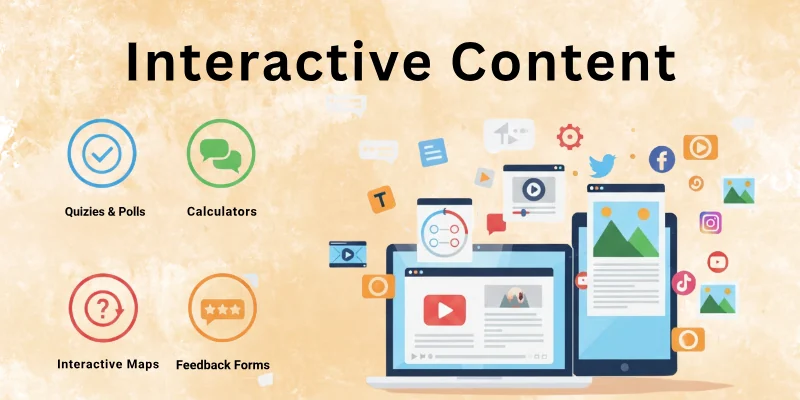
Quizzes
Type of assessments that give users a list of questions and possible answers, letting them see how much they know or what they like about a certain subject.
- Example: A language learning website might offer a quiz to gauge a user’s current level of proficiency.
- Pros: Fun and engaging way to educate the audience, motivates users to explore further learning resources.
- Cons: Requires careful question design, may not be suitable for all topics, especially those requiring in-depth explanations.
Polls & Surveys
Data collection tools that gather user opinions or preferences through multiple-choice questions or open-ended responses.
- Example: A clothing brand might conduct a poll on social media to see which color scheme is most popular for their new product line.
- Pros: Effective method for gathering audience feedback, provides valuable data for making informed decisions, improves content strategy and is relatively easy to create and implement on various platforms.
- Cons: Response rate can be a concern, to avoid user bias, question design must be objective.
Games
Interactive experiences that involve challenges, competition, and problem-solving, often with a set of rules and objectives.
- Example: A brand can develop a mobile game that reinforces brand awareness and product knowledge in a fun way.
- Pros: Highly engaging format , can be educational, offers entertainment value.
- Cons: Game development can be time-consuming, require specific skills or resources.
Contests & Giveaways
Promotional activities that encourage participation by offering prizes or rewards for completing a specific task or action.
- Example: A social media influencer might host a giveaway where users enter by following their account and commenting on a post.
- Pros: Effective strategy for audience growth and brand awareness, generates excitement and incentivizes user participation.
- Cons: Requires clear rules and prize fulfillment to maintain user trust and brand reputation.
Interactive Videos
Videos that combine aspects of user choice or control, allowing viewers to change the story or explore different content lines.
- Example: A travel website can create an interactive video showing off different vacation spots, letting users pick the ones that suit their interests and hobbies the best.
- Pros: Enhances viewer engagement, increases information retention, offers a unique way to tell stories and showcase content.
- Cons: Production can be more complex compared to traditional videos and requires technical expertise in interactive video creation tools.
Chatbots
Computer programs that let people talk to the computer by typing or speaking.
- Example: A customer service website might utilize a chatbot to answer frequently asked questions and provide basic support.
- Pros: Offers 24/7 customer support and assistance, can automate repetitive tasks and provide instant answers to basic inquiries.
- Cons: Chatbot responses need to be natural to avoid a frustrating user experience, limited capabilities in handling complex questions.
Social Media Content
There’s no denying that social media has become an important part of our digital lives. We can share content, connect with our fans, and build a community on this lively platform.
Let us look at the different types of social media stuff and talk about their pros and cons for each platform:
Facebook Posts
Text, image, or video updates shared on a Facebook profile or page.
- Example: A local restaurant might share a Facebook post featuring a mouthwatering photo of their new menu item.
- Pros: Wide reach, allows for long-form content like articles or detailed updates, integrates with Facebook groups for targeted community engagement.
- Cons: Organic reach can be limited by Facebook’s algorithm, competition for user attention is high.
Instagram Posts
Primarily photo and video sharing platform, with options for captions and hashtags.
- Example: A fashion brand might showcase their latest clothing line through visually appealing Instagram photos.
- Pros: Highly visual platform ideal for showcasing products, strong engagement, use of hashtags helps users discover your content.
- Cons: Limited text content compared to other platforms, requiring strategic posting.
Twitter Posts
Short-form text-based updates limited to 280 characters, often incorporating hashtags and mentions.
- Example: A news outlet might share breaking news updates and headlines on Twitter.
- Pros: Real-time communication, fast-paced information sharing, encourages discussions through mentions and replies, trending hashtags can increase visibility.
- Cons: Limited character count restricts the depth of information you can share.
LinkedIn Posts
A site for professionals to connect with each other, with posts about jobs, the business world, and new ideas.
- Example: A business professional might share an article they wrote about leadership strategies on LinkedIn.
- Pros: Career development opportunities, excellent platform for establishing yourself as an expert in your field.
- Cons: Content should be in a professional tone, building authority in your niche takes time and consistent effort.
Pinterest Pins
A platform based on images and videos that lets users “pin” them to digital boards based on their interests.
- Example: A home decor enthusiast might create Pinterest boards showcasing different interior design styles.
- Pros: Ideal for sharing visually compelling content, links from pins can drive traffic to your website.
- Cons: Relies heavily on high-quality visuals, effectiveness depends on effective use of relevant keywords and board titles.
Stories
Short, temporary video and picture updates that are shown one after the other on different platforms.
- Example: A vlogger might share Instagram Stories showcasing their daily adventures on a trip.
- Pros: Offers a casual glimpse into your personality, disappearing content encourages viewers to watch before it’s gone.
- Cons: Content disappears after 24 hours unless highlighted.
Live Videos
Real-time video broadcasts that allow for interaction with viewers in the moment.
- Example: A musician might host a live concert streamed on Facebook Live for fans around the world.
- Pros: Encourages a sense of connection with the audience, enables real-time engagement,
- Cons: Requires careful planning and technical setup for a smooth broadcast experience.
Other Types of Content
The types of content we have studied so far are traditional ones that have been around for a while. But in today’s rapidly changing digital world, as technology evolves, content formats are also changing every day. Here, I have mentioned three more content types that are currently trending with definition, example, pros and cons.
User-Generated Content (UGC)
Content created by users, such as reviews, photos, videos, or social media posts, shared on online platforms.
- Example: A customer might post a positive review of a restaurant on Yelp, including photos of their delicious meal.
- Pros: Authentic and trustworthy content from a user’s perspective, encourages user engagement, and is a valuable source of user feedback.
- Cons: Quality and accuracy of UGC can vary, copyright considerations are important when using UGC on your platform.
Virtual Reality (VR) Content
Computer-generated animations that take users to a virtual world and make the experience real and involved.
- Example: The pyramids of Egypt might be accessible through a virtual reality trip experience.
- Pros: Higher level of realism, making it harder to tell the difference between real life and simulation.
- Cons: VR technology can be expensive, content creation for VR requires specialized skills and software.
Augmented Reality (AR) Content
Overlays digital elements onto the real world viewed through a smartphone or tablet camera.
- Example: A furniture store might offer an AR app that allows users to virtually place furniture pieces in their homes to see how they would look.
- Pros: Blends the physical and digital worlds, creating interactive and engaging experiences.
- Cons: Requires compatible smartphones or AR glasses, limiting accessibility for some users.
Conclusion
Alright everyone, it’s time to bid farewell. This article has thoroughly covered all types of content. However, it’s important to remember that technology is progressing rapidly, and consequently, the nature of content is evolving as well.
All these variations in content ultimately stem from basic content types. Therefore, it’s crucial to keep yourself updated with new content types. Feel free to share your feedback on this article in the comment section.
FAQs
Here are some of the most commonly asked questions related to the types of content:
Both are visuals, but images can be illustrations or graphics, while photos are real-life captures using a camera. Somewhere these terms are interlinked, but with some what differences.
Videos are great for showing movement, telling stories, or demonstrating processes. Images excel for quick reference or showcasing static visuals.
Infographics present complex data in a visually appealing and easy-to-understand way. Inforgraphics add very interactive view, where you use that.
The best platform depends on your audience and goals. YouTube Live is great for reach, Twitch suits gamers and creators, and Facebook Live works well for community engagement.
Host challenges or contests to inspire creativity. Offer small rewards or recognition to motivate users. Engage with participants by sharing or featuring their work.
Podcasting works best for those who can create consistent, valuable content. It’s ideal for building authority and connecting with a niche audience. However, it requires planning, time, and good audio quality.
Always ensure you have permission to use a song. Use royalty-free or licensed tracks to stay compliant. Platforms like YouTube may remove or mute copyrighted audio.
Use visuals and minimal text to keep your slides clean. Tell stories or examples your audience can relate to. Practice to sound confident and natural.
Yes! They boost interaction and make your audience feel involved. They also help you learn more about your followers’ interests.
AR adds digital layers to the real world through your screen or glasses. VR immerses you fully in a computer-generated environment. Both offer unique interactive experiences.

- Be Respectful
- Stay Relevant
- Stay Positive
- True Feedback
- Encourage Discussion
- Avoid Spamming
- No Fake News
- Don't Copy-Paste
- No Personal Attacks

- Be Respectful
- Stay Relevant
- Stay Positive
- True Feedback
- Encourage Discussion
- Avoid Spamming
- No Fake News
- Don't Copy-Paste
- No Personal Attacks


